Article by LRWP Board President Heather Fenyk
Wikipedia tells us that civic science or citizen science (CS; also known as crowd science, crowd-sourced science, volunteer monitoring or networked science) is “scientific research conducted, in whole or in part, by amateur (or nonprofessional) scientists. Citizen science is sometimes described as public participation in scientific research, participatory monitoring and participatory action research.”
The LRWP employs civic science to better understand the health of our watershed. Our volunteers engage in activities like water quality monitoring, soil sampling, pollinator counts and mapping of invasive and threatened/endangered species. The data our volunteers generate is a key input to our analyses and restoration prioritization.
While the LRWP’s mission centers on protecting, preserving and restoring habitat and biodiversity within our Lower Raritan Watershed, our civic science approach to data gathering speaks to another core purpose: by training community volunteers to monitor and report on the health of the environment we work to ensure that science, community engagement and environmental stewardship become a permanent part of the culture and identity of the Lower Raritan Watershed.
Want to learn more about citizen/civic science? Not only how it is used to characterize the health of our watersheds, track climate change and map oil spills, but also how it can improve emergency responses, help us understand how diseases spread, and keep our drinking water clean? Check out the new PBS mini-series sponsored by The Crowd and The Cloud. For a month of Thursdays this April, PBS will host a 4-part television series exploring citizen science, crowdsourcing, and mobile technology. Below we summarize the episodes in the series:
Even Big Data Starts Small
The crowd, using mobile tech, and the cloud contribute to science that saves lives. In this episode, you’ll hear stories of everyday people contributing data used for emergency management, researching Alzheimers, mapping oils spills, and more.
World Broadcast: April 6th at 9pm EST
(replayed at 9pm PST)
Citizens + Scientists
Citizen scientists track air pollution in Wyoming, test for lead in Philadelphia’s drinking water, fish for data in coldwater trout streams and report environmental crimes in China, using the “Black & Smelly Rivers” app. Hear all these stories and more in Episode 2.
World Broadcast: April 13th at 9pm EST
(replayed at 9pm PST)
Viral vs Virus
Real-time data helps track environmental triggers for asthma sufferers and citizens confront air pollution and rising asthma rates by collecting real time data. In this episode, explore how maps and apps can combat globalized disease from asthma to Zika.
World Broadcast: April 20th at 9pm EST
(replayed at 9pm PST)
Citizens4Earth
This episode explores a Year in the Life of Citizen Science. Counting birds with an app, surfers collecting ocean data while they ride the waves, volunteers surveying horseshoe crabs on the Delaware Bay, and butterflies wintering over in California.
World Broadcast: April 27th at 9pm EST
(replayed at 9pm PST)
Article and photo by Joe Mish
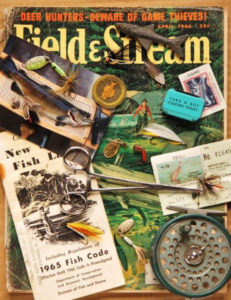
Field and Stream dreams come true on the South Branch of the Raritan. Opening day of the NJ trout season stirs memories as strong as a lifetime of Christmas morning and birthday surprises.
Right along with the anticipation of presents on Christmas morning, April and the opening day of fishing season both involved a dedicated countdown. For a month, each passing day was marked with a big X on the complimentary Esso service station calendar. It was understood, there would be no sleep on the eve of this once a year event.
Times have changed but tradition still lingers as many NJ anglers prepare for the opening of trout season in early April. One of the best places to live out a fishing fantasy is in Branchburg. As the name implies the township is bound for the most part by the North and South branches of the Raritan River, both heavily stocked with trout by the NJ Division of Fish and Wildlife.
Of course trout are not the only game in town. As the river flows from the mountains to the sea, fish can swim upstream as well as down. What that means is tiger muskies and hybrid bass can find their way downstream from Spruce Run as well as stripped bass, hickory and American shad can migrate upstream from the Atlantic Ocean. The state had been using an underwater camera to monitor quantity and species of fish in the area around the confluence of the Raritan and Millstone rivers, species you wouldn’t believe were observed. It was reported in a news article several years ago that trophy brown trout, walleyes, muskies, stripped bass, shad and several forage species were recorded. The beauty of fishing a river is you never know what you might catch.
While trout get the most press, the lower river is primarily a seasonal trout fishery with most angler activity occurring around opening day and subsequent stockings. It is considered to be ‘put and take’ fishing. There are holdover trout but you have to search for them. It is reported trout will travel distances to find suitable habitat with the water temperature being a prime factor. Each species has a preference for a specific temperature range so be sure to carry a thermometer if you want to become serious about your fishing.
The South Branch is also chock full of smallmouth bass which are a year around fish. Fish in the twenty-two inch range have been reported. Smallmouths in the twelve to fifteen inch range have a tendency to tailwalk on the surface of the water while their big brothers often stay deep and pull hard. My favorite lure for these ‘bronzebacks’ is a Panther Martin spinner with a small curly tailed grub on an ultralight fishing rod. Always have a hemostat or thumb forceps handy to remove the hook from any fish you wish to release.
Fishing methods and equipment span the spectrum of human imagination and most are effective on any given day. Expensive Orvis fly rods to lawn chairs and igloo coolers, garden worms to woolly buggers to Mepps spinners all take their share of fish. Fishing allows for as much science, superstition or tradition you might want to use in your piscatorial pursuits. There are even solunar tables which scientifically predict the best days to fish, however, everyone knows the best day to fish is whenever you get the chance.
So if your bumper sticker proclaims, “the worst day of fishing is better than the best day at work”, you already have your gear in ship shape condition and have started your countdown to the April 8th NJ trout season opener for 2017.
Author Joe Mish has been running wild in New Jersey since childhood when he found ways to escape his mother’s watchful eyes. He continues to trek the swamps, rivers and thickets seeking to share, with the residents and visitors, all of the state’s natural beauty hidden within full view. To read more of his writing and view more of his gorgeous photographs visit Winter Bear Rising, his wordpress blog. Joe’s series “Nature on the Raritan, Hidden in Plain View” runs monthly as part of the LRWP “Voices of the Watershed” series. Writing and photos used with permission from the author.
Article and photos by Joseph Sapia

Shekiro’s Pond in Helmetta
Joey Slezak grew up in South Jersey, but he has multi-generational roots in the Pine Barrens around Helmetta and has lived in his parental grandparents’s former house in Helmetta while studying at Rutgers University in New Brunswick. In his own right, Joey is a meteorology student at Rutgers, an outdoorsman, and, importantly to me in the outdoors, my go-to science guy.
I was looking forward to walking afield with him – perhaps not on as cold a day as February 18, 2015. Minus 1 degree at dawn and 9 degrees when I left my house about two hours later. But between our schedules, we had to take advantage of this opportunity, cold or not. Plus, we are woodsmen from Helmetta of tough local Polish stock. So, we plunged into the approximately 15 degrees when we finally started walking before 10 a.m.
A woodpecker hammered away. A few inches of snow covered the ground – on the surface, it was fluffy — and clung to trees.
“You could see the snow fall from the trees, these little flakes go by,” said Joey, 22-years-old at the time and working on his bachelor’s degree in meteorology.
On this day, we would spend much time in wetlands, including an Atlantic white cedar swamp being threatened by invasive phragmites.
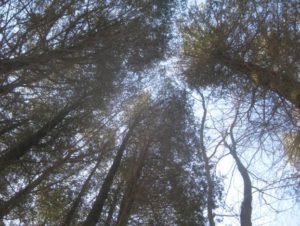
Looking skyward from the Atlantic white cedar swamp
“This is probably as secluded as you could be in these woods,” I said.
It was very quiet, until a jet airplane flew by.
“The final approach to Newark Airport comes over us,” Joey said.
Despite the cold, I was surprisingly warm.
“Once you heat up your clothes, there’s no wind to dissipate it,” Joey said. “(And) you’re dressed for it.”
I was dressed in long underwear, bottoms and tops; covered with a sweater and windbreaker jacket, all made of materials to wick sweat.
Joey pointed out hoar frost, a crystallized coating of frost. With the hoar frost, Mother Nature worked her art on any icy surface of water and on blades of vegetation.

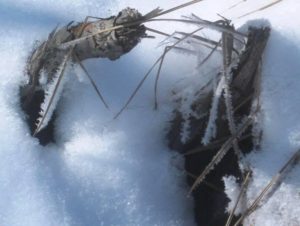
Mother Nature’s artwork: hoar frost.
Here and there, we were in danger of breaking through the swamp ice. I went up to my shins at one point, up to my thigh at another. Joey noted how he could smell the swamp when I broke through.
As we walked, we noticed evidence of the day’s low humidity – in the clarity and blueness of the sky.
“Not a cloud in the sky (hardly), a bluebird day,” said Joey, who, now in 2017, is working on his master’s degree in atmospheric science.
As we walked a sand road, we noticed fallen trees, lying northeast to southwest.
“That’s probably coastal,” Joey said, meaning a storm out of the east, rather than in the normal flow of wind from the west.
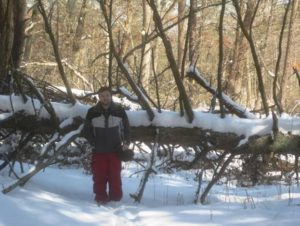
Joey Slezak at a treefall.
Perhaps the highlight of the day was hearing the call – a running-a-finger-along-the-teeth-of-a-comb sound — of a New Jersey chorus frog. This frog is an early caller, breeding as early as February, according to New Jersey Division of Fish and Wildlife literature.
“That sun’s getting warm,” Joey said.
By the time we ended the walk at lunchtime, the temperature was about 30.
“I had a lot of work to do, a lot of stress,” Joey said. “It felt pretty good to get out there.”
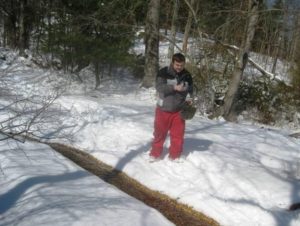
Joey Slezak at a small stream
Joe Sapia, 60-years-old, grew up and lives in the Pine Barrens around Helmetta, where his family has resided for more than 100 years. He can be reached at Snufftin@aol.com or at P.O. Box 275, Helmetta, 08828.
Article and Photos by Jess Niederer
On this rainy 2017 day, I am just fresh back in the office after a drive past a whole lot of farms. Many farms drain their surface water out to the road, and in these saturated conditions, you can usually see how well the farmers’ erosion prevention measures are working. You know when you should wince? It’s when that run-off in the ditches looks like chocolate milk. I saw a fair share of chocolate milk run-off out there today. Why should that bother us? It puts silt in the streams (smothers a healthy benthic zone ecology), it puts nutrients in the streams, it puts any present agricultural chemicals in the streams, and it takes topsoil (which takes 100 year/inch to form) off the field.
And someone, yes, a human, is gonna have to drink that water after some imperfect filtration process. Humans not your thing? Well, first the fishes will have to live in it. Scales don’t strum your heartstrings? Alright…the adorable baby foxes will have to drink it too. Not really an animal fan at all? OK, the nutrients may cause imbalanced plant growth in the ocean, and you’ll get a lot of seaweed on you during your beach day. If you don’t think of yourself as an environmentalist, don’t worry about it, I’m not trying to convince you. But it’s a guarantee that something you care about is negatively affected when a farm’s topsoil ends up in the creek.
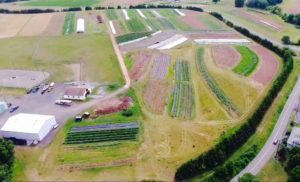
Contour Farming at Chickadee Creek Farm
GOOD NEWS though. The water running off our farm was clear. It wasn’t always like that, we had to work and change things up to protect the water. Through filter strips, contour farming, and being conscientious about when we till, we all win.
Jess Niederer is the owner of Chickadee Creek Farm, a certified organic and certified transitional organic* vegetable, flower and herb farm in Hopewell Valley, NJ. In 2016 she was named the National Outstanding Young Farmer by the Outstanding Farmers of America. Candidates are nominated from all across the country, and a panel of judges selects winners based on progress in their agricultural career, soil and water conservation, and service to their community, state, and nation.
Article and photos by Joe Mish
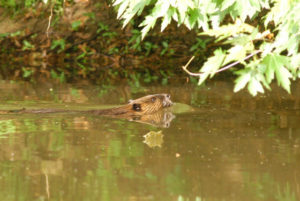
A beaver, whose existence is hidden in plain view, plies the local waters to shatter the belief the area is sanitized of wildlife typically associated with far off wilderness destinations.
As the earth turned its back to the sun on the first evening in January, the rising moon appeared as a thin silver crescent, low on the western horizon.
Just as the moon was high enough to reflect on the mirrored water of the North Branch, its perfect image was disturbed by a series of deep ripples that shattered the image into broken pieces of shimmering light.
The dark night, with minimal light reflected off the moon, made it difficult to see details, though it was clear that the disturbance was made by a beaver.
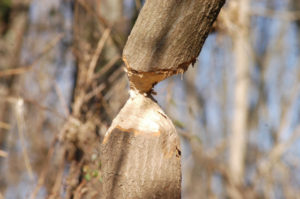
Earlier in the spring I had noticed a small tree cut down, showing unmistakable beaver sign, where a stump is gnawed evenly around, tapering to a perfect point.
For many years, beaver sign along the North and South Branch and Raritan rivers have been commonly seen in the January, February time frame. As the rivers are mostly shallow, the beaver are typically transients heading to the deeper water of the Delaware Raritan Canal or the Millstone to over winter. Many are killed by cars or trapped when they begin to fell trees across the road as was the case in Manville on the D&R canal.
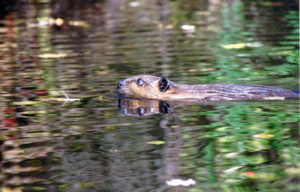
Beaver on the D&R canal built a den and felled trees across the road.
The odd thing about the freshly cut tree I saw, was that it was cut down in April. This was late in the year for a transient beaver. I kept watch all summer and saw no other sign until I noticed wide paths leading from the corn field to the river. The trail was too wide for a muskrat and too muddy for a groundhog. Apparently the beaver was feeding on corn all summer long. No sign of a den was apparent until the fall when the beaver began to cut branches and small trees, piling them at the base of exposed tree roots along a deep section of the river.
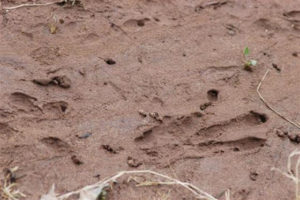
Beaver tracks in the mud along the Raritan River
It was now January, almost 3 months after the corn had been harvested and on this day the corn stubble was dusted with a light snow cover. The thin ice that formed along the banks showed a trail of bubbles made by the beaver as it traveled from its den to stockpile small branches for midwinter dining.
It was interesting to see where muskrats had been under the ice, leaving similar trails of exhaled air bubbles like the beaver, though the beaver left a trail of much larger air bubbles.
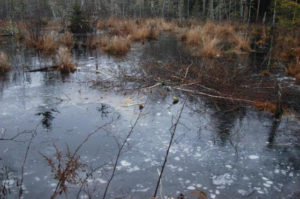
Exhale air from a beaver leaves large bubbles under the ice
Walking along the high bank and mindlessly following a set of fox tracks in the fresh snow, I saw where the beaver came ashore and went a short distance into the empty cornfield. The trail led to a vertical drop down the steep bank, which leveled off and then angled sharply to the right with a quarter turn to the left and directly into the water. It was apparent the beaver slid, rather than climbed back down into the water. A single footprint was evident where it corrected its slippery course.
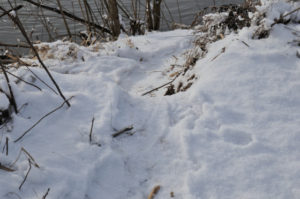
Notice the single footprint to the right side of the trail before the first drop
Further downstream across from the den there was an oak about 10 inches in diameter that the beaver had started to gnaw during the fall and abandoned in favor of several smaller trees 2 to 3 inches thick. That oak was now lying on the ground, a testament to the beaver’s determination, powerful jaws and sharp teeth. It will be interesting to see what the beaver will do with this large fallen tree.
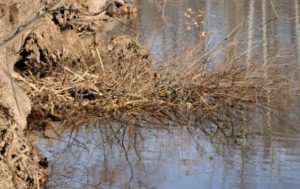
Beginnings of a beaver den or dam.
Beaver have always been associated with the wilderness, their pelts and castor glands served as motivation for French Canadian voyageurs and trappers to open the west after populations were depleted in the east.
To have beaver in our midst is a testimony to the tenacity of wildlife populations long thought erased from existence. It reminds me of Catholic school when the nuns told us to scrunch over in our seats to make room for our guardian angels. In a real sense, beaver are invisible guardian angels of our wild heritage that most people don’t believe exist and never consider.
Author Joe Mish has been running wild in New Jersey since childhood when he found ways to escape his mother’s watchful eyes. He continues to trek the swamps, rivers and thickets seeking to share, with the residents and visitors, all of the state’s natural beauty hidden within full view. To read more of his writing and view more of his gorgeous photographs visit Winter Bear Rising, his wordpress blog. Joe’s series “Nature on the Raritan, Hidden in Plain View” runs monthly as part of the LRWP “Voices of the Watershed” series. Writing and photos used with permission from the author.
Future of Menhaden Management – Public Hearing Thursday, December 8
Guest post by Zack Greenberg, Senior Associate, Environment | The Pew Charitable Trusts
Next week the Atlantic States Marine Fisheries Commission (ASMFC) is holding a hearing on the future of menhaden management. While ASMFC’s Menhaden Management Board unanimously approved the Public Information Document (PID) for Draft Amendment 3 for public comment, they need to hear from you on why it is so important to manage menhaden for their role in the marine ecosystem (Issue 1, Option D).
Tell the ASMFC that menhaden management must account for the needs of predators. The public can comment at upcoming hearings, or in writing, now through January 4, 2017. Here are the details for next week’s hearing in New Jersey:
New Jersey Division of Fish and Wildlife
December 8, 2016; 6:30 PM
Nacote Creek Marine Law Enforcement Office
360 North New York Road, Mile Marker 51
Port Republic, New Jersey
We need YOU to get involved, here’s how:
- Attend next week’s hearing on Thursday, December 8;
- Submit written comments before 5:00pm on January 4, 2017*; and,
- Share with family and friends to help get the word out!
*Public comments should be forwarded to Megan Ware, Fishery Management Plan Coordinator, 1050 N. Highland St, Suite A-N, Arlington, VA 22201; 703.842.0741 (FAX) or at comments@asmfc.org (Subject line: Menhaden PID).
The conservation of menhaden benefits everyone. Managing “the most important fish in the sea” to account for their role as forage fish will enable the population to continue to grow, while increasing menhaden’s value to recreational fishing, commercial seafood, and tourism businesses that all depend on this important fish and its predators. That is why we are supporting Issue 1, Option D.
If you haven’t seen it, here is footage of the amazing activity happening off New York and New Jersey, as we work together to protect hundreds of millions of menhaden and all that they provide to predators (including ourselves). It is hard not to get inspired when imagining what the Atlantic will look like when we restore this species to its historic abundance and range!
There are a lot of articles out there on the importance of menhaden, a few can be found by clicking below:
Remember: this is YOUR opportunity to provide input on the future management of this incredibly important forage fish – the ASMFC wants to hear from you – so make your voice heard!
Dear Friend of the Lower Raritan Watershed –
In 2016 you and your neighbors joined the LRWP for:
16 clean-ups of area streams
1 pollinator garden installation
1 rain garden installation
3 water quality monitoring trainings (visual habitat, pathogens and macroinvertebrate identification)
3 multi-week K-12 environmental education programs
9 stakeholder meetings
7 special events (dance performances, gallery openings, field trips and special lectures)
10 community meetings, environmental festivals or other outreach events
2 blessings of area streams
You also: adopted 20+ stream segments for habitat monitoring, took soil and water samples, spearheaded 30+ research/internship projects, volunteered to help shape the LRWP’s strategic and business plans, developed maps, gave presentations, created 20+ sculptures out of trash, provided counsel and advice, and so much more. For your time and commitment to a healthier Lower Raritan Watershed, we say a very sincere THANK YOU!
Now we come to you, humbly, to ask for more. We cannot advance our collective work on the path to a healthier Raritan River and Lower Raritan Watershed without your financial support. So please consider the Lower Raritan Watershed Partnership in your charitable giving.
CLICK HERE TO DONATE
We know there are many good charities that will seek your help. We are truly honored when you choose to make a tax-deductible gift to the Lower Raritan Watershed Partnership.
With all the best to you and your family for a wonderful holiday season and a happy, healthy 2017.
Heather Fenyk
President and Founder
Lower Raritan Watershed Partnership
Except as noted, article and photos by Joe Mish
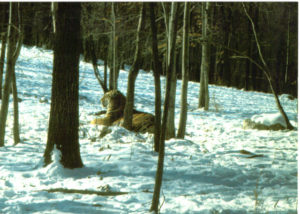
A Siberian tiger, out of place in modern times in New Jersey, comfortably rests on the frozen snow in sub zero temperatures, intensified by a strong northwest wind. Conditions that would turn exposed flesh beet red in an instant, didn’t phase this big cat as it appeared oblivious to the deadly weather; as if not bound by the laws of Nature.
It was a bitter cold day as Bert and I drove the Warner Bros Jungle Habitat trails to check on the open ranging wildlife that occupied the windswept mountains and valleys of the northern New Jersey wildlife park. Inside the warm Chevrolet truck, converted into a veterinary mobile unit, the heater was turned up high, while warm coffee steamed the windshield. Most animals escaped the polar wind hiding behind natural windbreaks and temporary shelters placed around the park.
As we drove past the tiger compound, near the highest point of the park, here was this tiger, a cat we affectionately named, ‘Bobtail’, lying down exposed to the full force of the wind. Bearing an ever present grin, for which the big cats are known, Bobtail appeared content, oblivious to the deadly arctic blast. He remained motionless and stared into the brutal wind that must have escaped from the 10th circle of Dante’s frozen hell, showing no signs of discomfort. He may as well have been enjoying a cool breeze on a warm summer’s day.
This image of Bobtail lying in the snow captures for me the essence of the tiger. Well documented accounts of tigers hunting humans in India, and their magical ability to make kill after kill and avoid inescapable traps, have elevated the tiger to supernatural status.
This is an animal believed to exist in the spirit world as a cunning killer with the ability to transform into flesh and bone and back again at will. The tiger has a reputation of defying natural law that limits all other living things; Bobtail was doing nothing to dispel that myth on this cold day.
The poem, “Tyger”, by William Blake, written in 1794, so well captures the visceral reaction I had to the tigers, I memorized the poem. Here are a few lines that chill my blood.
In what distant deeps or skies Burnt the fire of thine eyes?
And what shoulder, & what art. Could twist the sinews of thy heart?
While here is photographic proof of a tiger living in New Jersey, an anomaly for sure, it is not hard to imagine a time when big cats stalked our land. I wondered every time I passed the tiger compound, how humans ever survived these Paleolithic predators. Perhaps it was the predators’ evolved intelligence that raised the level of human creativity in a Darwinian dance played to a deadly tune.
Evidence of saber tooth cats and jaguars, among other prehistoric creatures, were found in a limestone cave in southeastern PA near Pottstown and trace back to the cretaceous period about 100 to 66 million years ago. The cave was located in a now forgotten town named Port Kennedy, which is part of Valley Forge National Park.
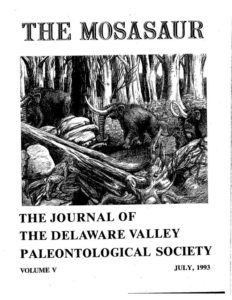
Evidence of sabre-tooth cats of the late cretaceous period discussed in this 1993 article. Additionally fossil remains have been found in the Cutter Clay works near Raritan Bay and along the shore across Raritan Bay in Union Beach.
NJ was unrecognizable in terms of geography and climate with glaciers terminating at the Watchung Mountains and our rivers not yet formed. The Hudson River at one time was thought to have emptied into the lower Raritan watershed at Bound Brook.
As the sea level rose and fell over the eons, it formed clay banks along the Raritan and its bay where dinosaur fossils and tracks have been found. To date, I am not aware of any prehistoric cat trackways or fossils being discovered in NJ. Though surely, when southern NJ was above water, it would be reasonable to expect prehistoric cats, whose remains were found in the Port Kennedy Cave, to have roamed our land.
In more modern times the eastern mountain lion did stalk the shores of the Raritan and in fact a bounty was offered and the last local cat killed in the Sourland Mountains in the early 19th century. Officially, the last New Jersey mountain lions were killed in the southern most counties about that same time.
Rumors of mountain lions persist in several north east states, though no hard evidence has been uncovered in NJ. Given the fact that people have been known to illegally harbor large cats in less than secure enclosures, anything is possible.
Today, New Jersey has a healthy population of bobcats, primarily in the northwest part of the state. The retreating glaciers left a boulder strewn, mountainous landscape with plenty of nooks and crannies, ideal habitat for these elusive felines. Occasionally bobcats are captured on hunters’ trail cameras to give us evidence of their presence as they are rarely ever seen even where they are plentiful.
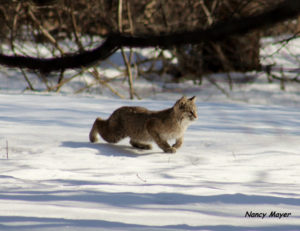
This very rare photo of a bobcat was taken in Warren County, NJ. New Jersey has a healthy bobcat population along with other wildlife thought not to exist within our borders. This cat is really a sabre-tooth tiger distilled down to miniature with all the accumulated intelligence and instincts required for survival in any geologic iteration of New Jersey. Photo by Nancy Mayer
Still the thought of saber-tooth cats, tigers and jaguars ranging across the state becomes more than just imaginary when you see the gleam in your pet cat’s eye. It is as if the prehistoric felines have been distilled down to their essence in the form of modern day cats that dominate many of our homes.
“The Man-Eaters of Kumaon”, by Col Jim Corbett, published in 1944, deals with the man eating tigers of India in the early 20th century. Please read the last chapter, “Just Tigers” before you begin the book as it puts the tiger in perspective and talks about photography vs hunting and concern for their the conservation even at that time. The first hand account of the almost supernatural ability of tigers to avoid being killed or captured while hunting humans, reveals an intellectual battle where man doesn’t always dominate nature.
THE TYGER
By William Blake
Tyger! Tyger! burning bright In the forests of the night, What immortal hand or eye Could frame thy fearful symmetry?
In what distant deeps or skies Burnt the fire of thine eyes? On what wings dare he aspire? What the hand dare sieze the fire?
And what shoulder, & what art. Could twist the sinews of thy heart? And when thy heart began to beat, What dread hand? & what dread feet?
What the hammer? what the chain? In what furnace was thy brain? What the anvil? what dread grasp Dare its deadly terrors clasp?
When the stars threw down their spears, And watered heaven with their tears, Did he smile his work to see? Did he who made the Lamb make thee?
Tyger! Tyger! burning bright In the forests of the night, What immortal hand or eye Dare frame thy fearful symmetry?
1794
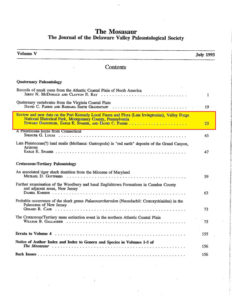
Author Joe Mish has been running wild in New Jersey since childhood when he found ways to escape his mother’s watchful eyes. He continues to trek the swamps, rivers and thickets seeking to share, with the residents and visitors, all of the state’s natural beauty hidden within full view. To read more of his writing and view more of his gorgeous photographs visit Winter Bear Rising, his wordpress blog. Joe’s series “Nature on the Raritan, Hidden in Plain View” runs monthly as part of the LRWP “Voices of the Watershed” series. Writing and photos used with permission from the author.
The Nature Conservancy recently asked the Lower Raritan Watershed Partnership to identify the top issues facing the communities with which we work. We developed our “Top 10” list, below.
A few caveats to this list. First, the Lower Raritan Watershed is comprised of a diversity of communities facing a varied set of issues. Each community would likely identify a different set of priority issues. Second, the LRWP has not conducted a comprehensive survey of need (although it is something we would like to do). The following issues have been identified during discussions with communities, by daily culling of google for Raritan River and watershed-related news stories, reading minutes from Environmental Commission, and from general observation. Many of these issues are inter-related, but we have culled them out as they often seem to be discussed singly.
We very much welcome stakeholder comments, input and suggestions to the add to our list.
- Substandard quality of area waters due to toxic contamination and contamination due to disease-causing pathogens. This bears not only on fishing, swimming and secondary contact, but also on concerns with drinking water quality.
- Uncertainty regarding the quality of area waters: lack of readily accessible (and easily interpreted) information about water quality.
- Linked to, but distinct from the above: the need for restoration of historic contaminated sites and waterways to protect public health.
- Sea level rise, and assistance with preparedness / resiliency planning.
- Flooding, significant impervious surfaces, and disruption of natural / historic hydrologic flows.
- Stormwater runoff and the need for regional stormwater management, including assistance with meeting MS4 requirements from County/state or other regional entity.
- Fragmentation of habitat, including fragmentation of human scale habitat (e.g. walking and bicycling routes).
- Perceptions of safety around riverfront spaces and streams deters use of these spaces (e.g. significant homeless populations, poor lighting, limited access and/or limited signage).
- Aging rail infrastructure that could lead to devastating spills in our waterways.
- Threat of pipelines or other significant infrastructure that might damage habitat.
Article by Dorothy Lee, Rutgers University Sophomore and LRWP Summer Soils Intern
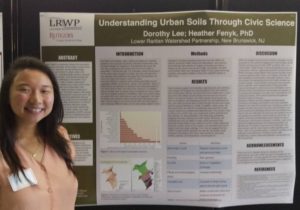
LRWP intern Dorothy Lee, presenting at Rutgers (photo by Heather Fenyk)
This summer I had the opportunity to intern for the LRWP doing soils and civic science research. My job was to conduct initial research into how the LRWP could develop a civic science soil monitoring program to better understand soils functions for an urban watershed level. Urban areas can benefit from soil mapping exercises because urban soils are a concern for food supply, drinking water, stormwater control as well as aesthetics and recreation. Particular issues of urban soils are related to impervious surfaces, erosion, land filling and land leveling, surface removal, contamination, sedimentation and severe compaction. The benefits of working with civic scientists to aid in research means that data can be collected efficiently and in a timely manner while simultaneously connecting the community to their environment.
The LRWP’s specific interests as they relate to soil include soil enrichment for stormwater retention and for bionutrient food availability. After researching these issues, I worked with LRWP President Heather Fenyk and Professor Stephanie Murphy, Director of the Rutgers Soil Testing Lab, to identify ways that the LRWP could begin to engage the Lower Raritan Watershed community in soils research. A few of the actions we thought could orient conversation for future soil-health-oriented civic science studies include: having area civic scientists work to identify “new” bacterial phyla, linking soil health improvement goals to impervious cover remediation actions planned at the municipal level, and evaluating rain gardens as a management strategy to increase soil C, optimize soil N cycling processes, and reduce leaching and gaseous emission losses of nitrogen.
The LRWP is also beginning to develop a plan to communicate the benefits of composting for soil enrichment. This relates directly to my work at Rutgers with a new club, RU Compost. Compost is an efficient way to reduce our food waste, cycle nutrients back into our soils, and create more awareness and education opportunities to the public. At Rutgers our club is working to implement composting in our dining halls and students centers, and we are also working on building a compost demonstration for the Spring semester in the Lower Raritan Watershed. Look for us in the spring!




















